EARLY CHURCHES OF GREENE County
Unless otherwise noted, the source for Early Churches of Greene
County was "The Heritage of Greene County" published by Heritage
Publishing Consultants, Inc. The year the church was first
established is in parentheses next to the church's name. The year
the church stopped services is given where available.
Bethsalem Presbyterian Church, Boligee (ca 1835-1917)
Bethsalem, which means "House of Peace" was the first church in
Boligee. It was built on land donated by Colonel George Hays, an
early Boligee settler.
Bethsalem
Cemetery is located next to the church and is still active.
Beulah Baptist Church, Snoddy
(February 3, 1833) now in Greene originally Pickens.
Charter members were Elizabeth Brooks, David S. Brooks, Thomas J.
Drummond, Nancy Leatherwood, John Leopard, Albert M. Tandy, Matilda
Tandy, Ralph Tandy, Luke Thornton, Sarah Thornton, Rev. Matthew
Pickett Smith.
The first building was of hewn logs, but today on the same
property, are located the red brick sanctuary and educational rooms
erected 1948.
Rev. Matthew Pickett served as pastor 1836-1881.
The first Sunday School was organized 1877 with Thomas J. Nix
serving as superintendent.
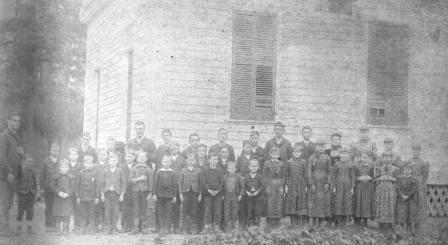
Beulah Baptist Church once served the dual purpose
of school and church
Beulah Baptist
499 burials recorded as of Oct. 2007
Boligee Presbyterian Church, Boligee (1930)
The church was built on land donated by Mrs. Julia C. McLemore
and still stands today. Mr. J. T. McLemore was elected and ordained
the first elder of the church and Dr. W. R. Hatter, first deacon. At
the organization of the church there was an enrollment of
forty-eight members.
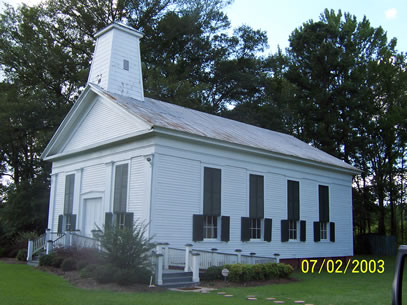 Clinton Baptist Church (1838) Clinton Baptist Church (1838)
This church was organized in
1838 as Concord Baptist Church, located nearby in Trussells Creek.
The first minister was Rev. William Manning. Charter members were:
Mr. and Mrs. Moses Buttler, Mr. and Mrs. Thomas Childs, Mr. and Mrs.
Marshall Keith, Mr. John Richardson, Miss Elizabeth Tutt, and Mr.
and Mrs. W. O. Williams. After seven years the name was changed to
Clinton Baptist Church to reflect the location in the community. The
church membership grew considerably in the late 1840's and 1850's.
This growth along with frequent flooding of Trussells Creek led the
congregation to erect a new building. (From Historical Marker
located at the Church)
Ebenezer Church, Forkland,
see Lambuth Memorial Methodist
Church.
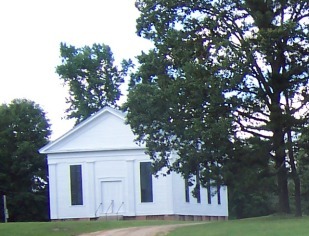 Ebenezer Presbyterian Church, (1828 - present) Ebenezer Presbyterian Church, (1828 - present)
(pictured at right) This
historic Greek Revival style church was organized in 1828 and still
has its original pews. The church stood empty for 77 years when the
Greene County Historic Society acquired the building in 1994 and
then subsequently leased the church to the First Baptist Church of
Clinton in 2003.
All records for this church are in the Historical Foundation,
Montreat, N.C.
Ebenezer Presbyterian
382 burials recorded as of Oct. 2007
Eutaw Baptist Church (1841)
The first church was built on
Boligee Street on a lot acquired from Asa White in 1843. The
original building was destroyed by a cyclone in 1900 and was rebuilt
and subsequently destroyed again by fire in 1930.
The present church was completed in 1953.
Eutaw United Methodist Church (1840)
A wooden church was
erected in 1841 on the northwest corner of Boligee and Wilson
Avenue. Richard Henry Herbert was the Pastor and Elisha Calloway was
the presiding Elder at the first quarterly conference on 15 August
1840. The original church was replaced and the new brick church was
first used on 17 September 1961[3].
See also
History of
Methodism in Greene County.
Eutaw Christian Church

Eutaw Christian Church, Eutaw (1895)
The Eutaw Christian
Church (pictured at right) was organized in February of 1895 and the building was
erected in 1908. Information from a postcard dated ca 1969, pictured
at right.
First Presbyterian Church of Eutaw (1851)
Main Street, Eutaw, Alabama.
Erected 1851, David R. Anthony Contractor. Organized by Tuscaloosa
Presbytery in 1824 as Mesopotamia Presbyterian Church. John H. Gray
first minister 1826-1836. Educational Building Erected 1959. From
Historic Marker.
Forkland Church - see Lambuth Memorial Methodist Church.
Friendship Baptist Church, Boligee (1825)
The Friendship Baptist Church was organized at Burton's Hill. The
church moved to its present site in Boligee, and was rebuilt
on land given by Mr. A. B. Demoville.
Green's Chapel CME Church
Reverend O. C. Watts, P. C., is written on the side of this church, located at the corner of Highway 69 and county road 64 in West Moundville just south of Havana. A short distance down county road 64 is Tucker Cemetery, which is on the
corner of 64 and Tucker Cemetery Road facing 64; if you turn onto Tucker Cemetery
Road there is a second cemetery immediately on your left.

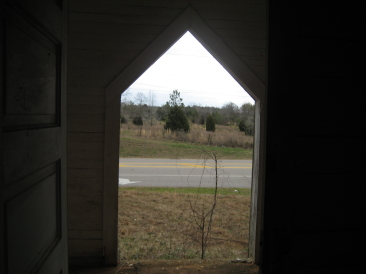

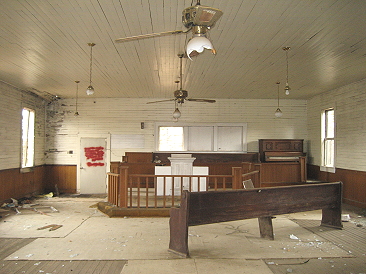
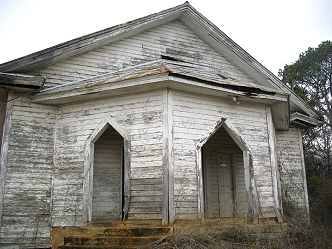
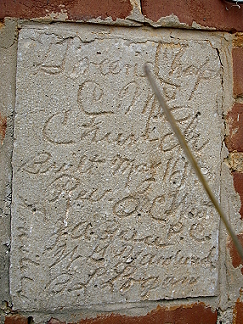
click thumbnails for larger photos
Hebron Presbyterian Church,
Mantua (1822-1931)
Reverend Andrew Brown preached the
first sermon in 1822. The church was organized in 1824 when Reverend
Thomas Archibald settled in the area and both Hebron and the New
Hope Church at Knoxville. In 1856 Hebron had two hundred forty-four
members making it the largest Presbyterian church in the area. After
the war between the states, the population declined and the building
became neglected and finally collapsed in 1918. The church was
dissolved by the Tuscaloosa Presbytery in 1931.
Hebron Presbyterian 273 burials recorded as of Oct. 2007
Johnson Hill United Methodist Church (1886)
Also known as
"Grove Valley Church"
Lambuth Memorial Methodist Church (ca 1823)
The Lambuth Memorial Methodist Church was organized about 1823
and was known at that time as Ebenezer Church. The deed to the old
Ebenezer lot of four acres was made November 5, 1839 for ten dollars
by James Kirkpatrick to the following Trustees of Greene Circuit:
William Massie, Charles C. Jordon, John McGee, William Daniel, Basil
Crawford, Ferdinand Sealey, Isaac Gregory, Samuel O. Gordon, and
George W. Hill. Ebenezer was the original name of Forkland Church,
but apparently the name gradually was forgotten and the church was
just called Forkland Church. On February 6, 1955 the members of the
church voted to change the name to Lambuth Memorial Methodist
Church.[4]
View
1967 program Lambuth Memorial Methodist Church page 1,
page 2.
Lloyd Chapel Baptist Church ( ca 1880)
Mesopotamia Presbyterian Church (1824- ca 1851)
Founded by
the Tuscaloosa Presbytery in 1824, the building was constructed in
August of 1833 on Finches Ferry Road. The first minister was Rev.
John H. Gray who served from 1826 - 1836. The church was
disassembled
in 1851 and its materials were used to construct the Samuel R.
Murphy house. The congregation purchased property in 1847 on the
northwest corner of Wilson and Main streets in Eutaw. The cemetery
was deeded to the town of Eutaw. The original name of the cemetery
was Oak Hill. See the First Presbyterian Church
of Eutaw for more information.[1,3]
Mesopotamia 1338 burials
currently recorded online of about 2000 total, in-process Oct. 2007
Mt. Pleasant C.M.E. Church and Cemetery, Knoxville
On the 25th day of May, 1901,
Norville Dunn, a farmer, in consideration of the sum of fifteen
($15.00), deeded property in Knoxville Alabama, Greene County to the
trustee board of Mt. Pleasant Colored Methodist Episcopal Church, to
build a community cemetery.
The land for the cemetery consists of 3,375 square yards. (A little
less than an acre.) African-Americans are the only persons buried
in this cemetery.
In 1922, a burial society was formed which still exists today.
People who joined the society paid dues of 25 cents each month to
defray the cost of their burial. Members of the society did not have
to be members of the church and could choose to be buried
elsewhere.
In 1990, the cemetery began running out of space for burials and
decided to restrict burial only to church members who were in good
standing and paid their tithes regularly.
No record has been kept of how many bodies are buried in this
cemetery. Many families chose to bury their loved ones on top of
each other. Some graves are marked with hickory rocks and the
engravings were done with a chisel by hand. Other graves have no
markers.
(Information provided by Juanita Duff 2007)
Mt. Pleasant, 153 burials recorded as of Oct. 2007
New Hope Presbyterian Church, Knoxville (1818)
The New
Hope Presbyterian Church was founded by families who immigrated from
South Carolina, including the families of: Major Thomas, White,
James Storey, David Morrow, Abner Steele, William Baskins, and
Edward Mays. Reverend Andrew Brown was the first minister. In
January of 1973 the membership of New Hope combined with the Eutaw
Presbyterian Church.[3]
New Hope AKA Knoxville, 206 burials recorded as of Oct. 2007
 Pleasant Hill Cumberland Presbyterian Church (1832) Pleasant Hill Cumberland Presbyterian Church (1832)
Pleasant Hill Cumberland Presbyterian Church was established in
1832, and its original address was Clinton, Alabama. The original
land upon which the building was erected was given by John Gandy and
his wife Harriet. The original building burned and was replaced with
the present-day building. The cemetery next to the church is well
kept and still active, with burials dating from 1837 to present. The
earliest burial was Nancy Cockrell, born in 1757, died 27 Jun 1837.
Some of the earliest birth dates include Allen Richardson
(1780-1845), Loucinda Richardson (1775-1864) and William Hinton
(1779-1864). Not all stones are legible and some are missing.
NOTES from Jim Taylor pertaining to the early members
documents linked below:
Bottom of 1st page Rebecca A[nn] E[lizabeth] Mapey, sister of Elmira Jane Gammill,
daughters of Elizabeth Gammill (3rd
name up from the bottom.) Rebecca married William T. Massey about
1859/1860 [probably the same William T. Massey listed on the same
page and denoted as "DECEASED"]. He killed himself on 15 Jan 1860 and she married
second William
Augustus Powell in 1866. Rebecca was a "Massey" between 1860 and 1866 therefore,
these pages are most likely from that time period.
Original Documents for Pleasant Hill members page 1,
page 2.
Pleasant Hill - Black Americans, 204 burials recorded as of Oct. 2007
Pleasant Hill - White Americans, 448 burials recorded as of Oct. 2007; Jefferson J. Powell is
supposed to be buried here per Mr. Jim Taylor - to date we have not
found Mr. Powell.
*In this time period the letter "P" denotes double "s" - therefore, "Mapey"
then is "Massey" now. cls*
Pleasant Ridge Presbyterian Church (1848)
By appointment
of Tuscaloosa Presbytery, Rev. J. L. Kirkpatrick and Rev. C.A.
Stillman met on November 18, 1848 and organized a Presbyterian
church at Pleasant Ridge, Alabama.
There were thirteen charter members. Services were held in a home
near the site of the present church. The first pastor, Rev J. P.
McMullen served from 1855 until he was killed while serving the
Confederacy at Resaca, Ga. 1864.
The church building was erected in 1859, and has been a blessing
to all who have worshipped here through the years. (From the
historic marker at the church)
Pleasant Ridge, 312 burials recorded - there are most likely many more further back in the woods
Salem
Methodist Church "attached" to the Eutaw Church in 1956.
Salem Methodist, 140 burials recorded as of Oct. 2007
 Sardis Methodist Church (1830) Sardis Methodist Church (1830)
Located in West Greene, (pictured at right).
The date the church was first established is from the sign in
front of the church. The church has a well-maintained cemetery
across the street with many of the forefathers of the West Greene
area.
Sardis
Methodist, 161 burials recorded as of Oct. 2007
Shiloh Baptist Church (ca 1853)
Springfield Church
was 2 miles Northeast of Eutaw and was later absorbed by the Eutaw Church.
St. John's-in-the-Prairie Episcopal Church (1834)
Organized "in the Prairie" south of Greensboro in 1834 by the Rev.
Caleb Ives, pioneer missionary to the old Southwest. Admitted to
parish status in 1838 by the Rt. Rev. Jackson Kemper, Provisional
Bishop of Alabama. First rector was the Rev. John Avery, D. D.
Present building designed by Mr. Richard Upjohn, renowned American
architect and founder of the American Institute of Architects.
Erected in 1859 and moved across the Warrior River to its present
location in 1878. (from the historic marker at the church)
St. John's, 38 burials recorded as of Oct. 2007
Saint Mark's Episcopal Church, Boligee (1852)
Some of the early members of St. Mark's Episcopal Church include
John G. Friend, A. Little, P.L. Lightfoot, William P. Gould, and J.
J. Thornton. St. Marks was
originally located about four miles from Boligee. The building was
moved to its present site in Boligee in 1880.
St. Mary's Catholic Church (1948)
Six Catholic women, Mrs.
John Bluneschi, Miss Ruth Neilan, Mrs. Wiles Banks, Jr., Mrs Walter
McAlpine, Mrs. Roland Steele and Mrs. William Lee raised the money
to build the first Catholic church in Eutaw on land donated by Anna
McAlpine, daughter of Mrs. Walter McAlpine[3].
St. Stephen's Episcopal Church, Eutaw (1847 - present)
St.
Stephens Church was erected on land purchased from Asa White in 1847
and was dedicated by the Rev. J. H. Tichnor on 25 November 1848. The
church burned 14 February 1913 and was rebuilt with some of the
original fittings and the original altar. [2]

Postcard ca 1966, St. Stephen's Episcopal Church
"Founded in 1845. Present building completed in
1914."
Sources:
1. Clay Lancaster, The Builders and Architecture of an
Ante-Bellum Southern Town, (1979: Eutaw, Alabama, The Greene County
Historical Society), 48
2. Ibid, 50.
3. Mary Morgan Glass, A Goodly Heritage Memories of Greene County
(1977: Eutaw, Alabama, Greene County Historical Society)
4. Lambuth Memorial Methodist Church, A Short History (Brochure),
22 January 1967.
|